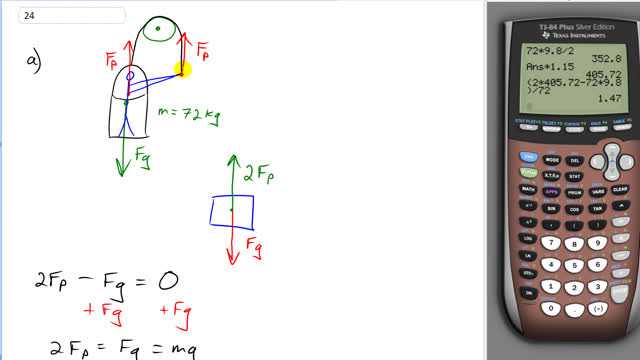
A window washer pulls herself upward using the bucket–pulley apparatus shown in Fig. 4–48.
- How hard must she pull downward to raise herself slowly at constant speed?
- If she increases this force by 15%, what will her acceleration be? The mass of the person plus the bucket is 72 kg.


In order to watch this solution you need to have a subscription.
This is Giancoli Answers with Mr. Dychko. So, this window washer pulls down on the rope with her hands and then the rope in turn has a Newton's third law reaction force which pulls up on her hands with the same size force. And so, that's what this is here. I'm just showing the forces that are exerted on this window washer and the bucket. So, just, you know, to explain that a bit better. You could say that the window washer is exerting a force downwards on the rope due to the washer and then there's a force upwards on the washer due to the rope. And that's what this one is, Fp, force on the person. OK. And then a result of this pulling down on the rope is that the rope is gonna have some tension in it, and since the rope is attached to the bucket it's going to be exerting that tension force upwards on the bucket. And so, this force with which she's pulling down on the rope gets multiplied by two because on the one hand the reaction force on her hand is pulling her up with the same force that she's pulling down. And then in addition there's the tension in the rope pulling up on the bucket with the same force. And so, there's two times the force that she's pulling upwards and then there's only force gravity downwards. So, there's a free body diagram. So, we have two Fp minus Fg equals 0 because in part A she's moving at a constant speed, and add Fg to both sides, and we get 2 times force of the pole is mg. And then divide that by 2 and you get 72 kilograms times 9.8 Newtons per kilogram, divided by 2 which is 315 Newtons to move at constant speed. And then in part B we say, let's suppose that she pulls with 15% more which means x 1.15. And that would be 405.72 Newtons of force that she's pulling with. And the free body diagram is the same. But this time it doesn't equal zero anymore. Instead of equaling zero, it equals ma, is going to be some nonzero acceleration which we have to calculate. So, we divide both sides by m. And so, acceleration is 2 times the pulling force minus mg all divided by m. So, that's two times 405.72 Newtons minus 72 kilograms times 9.8 Newtons per kilogram and divided by 72 kilograms gives 1.5 meters per second squared acceleration upwards.
When you're multiplying by 15%, why do you use 1.15?
when you multiplied by 15%, why did you do 1.15 and not .15?
If 1=100% of initial value and we want to add an additional 15% (0.15) Then total is 1.15
Thank you for chipping in with the answer hexxilated!